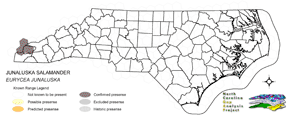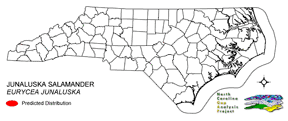
| Taxa: |
| Order: |
| Family: |
| Amphibia |
| Caudata |
| Plethodontidae |
| NatureServe Global Rank: |
| NatureServe State (NC) Rank: |
| G2Q |
| S2 |
| Federal Status: |
| NC State Status: |
| FSC |
| SC |


| Land Unit |
| US Fish & Wildlife Service |
| US Forest Service |
| US National Park Service |
| US Department of Defense |
| NC State Parks |
| NC University System |
| NC Wildlife Res. Com. |
| NC Forest Service |
| NC Div. of Coastal Mgmt. |
| Local Governments |
| Non-Governmental Org. |
| Other Public Lands |
| Private Lands |
| GAP Status 1-2 |
| All Protected Lands |
| Statewide |
| Hectares |
| 0.00 |
| 795.24 |
| 4.59 |
| 262.26 |
| 0.00 |
| 0.00 |
| 0.00 |
| 0.00 |
| 0.00 |
| 0.00 |
| 0.00 |
| 0.00 |
| 637.02 |
| 357.21 |
| 1,057.50 |
| 1,699.11 |
| Acres |
| 0.00 |
| 1,965.08 |
| 11.34 |
| 648.06 |
| 0.00 |
| 0.00 |
| 0.00 |
| 0.00 |
| 0.00 |
| 0.00 |
| 0.00 |
| 0.00 |
| 1,574.11 |
| 882.68 |
| 2,613.14 |
| 4,198.59 |
| % of Dist. on |
| Prot. Lands |
| 0.0 % |
| 75.2 % |
| 0.0 % |
| 24.8 % |
| 0.0 % |
| 0.0 % |
| 0.0 % |
| 0.0 % |
| 0.0 % |
| 0.0 % |
| 0.0 % |
| 0.0 % |
| 0.0 % |
| 33.8 % |
| ----- |
| ----- |
| % of Dist. on |
| All Lands |
| 0.0 % |
| 46.8 % |
| 0.3 % |
| 15.4 % |
| 0.0 % |
| 0.0 % |
| 0.0 % |
| 0.0 % |
| 0.0 % |
| 0.0 % |
| 0.0 % |
| 0.0 % |
| 37.5 % |
| 21.0 % |
| ----- |
| ----- |
|
This is a relatively rare species, found along the border of Tennessee and North Carolina in tributaries of the Little Tennessee and Little Pigeon Rivers (Petranka 1998). The salamander is restricted to lower slopes and valleys of the mountains and Tennessee foothills, where the distribution of populations is patchy (Petranka 1998). Populations can be found concentrated around large creeks (Petranka 1998). It shelters under rocks, logs and other debris in moist conditions near streams (Petranka 1998). NATURE SERVE GLOBAL HABITAT COMMENTS: Adults hide under objects in or along streams at elevations between about 360-610 m. Found on roads on rainy nights. NATURE SERVE STATE HABITAT COMMENTS: Associated with wider, base-level portions of streams and rivers. |
| Code | Name | Description | NC Natural Heritage Program Equivalent |
| 517 | Hemlock Floodplain Forest | Alluvial forest with hemlock and/or white pine in mountains and western piedmont. Hydrology is generally temporarily to seasonally flooded. | Canada Hemlock Forest |
| 521 | Spruce/Fir Forest | High Elevation Frazer-Fir - Red Spruce, Red Spruce and Red-Spruce-Yellow Birch Forests. Tree densities included here include both woodland to forest density. Highly intermixed with Northern Hardwoods, Grassy Balds, and Shrub Balds. | Red Spruce--Fraser Fir Forest, Fraser Fir Forest |
| 522 | Northern Hardwoods | High Elevation forests including yellow birch, American beech, and yellow buckeye. Includes forests with Hemlock and Yellow Birch. | Northern Hardwoods Forest, Boulderfield Forest |
| 525 | Appalachian Oak Forest | A variety of oak forest types including Black, White, Scarlet Oaks in dry to mesic situations. Includes forests historically co-dominated by American Chestnut. | High Elevation Red Oak Forest, Montane White Oak Forest |
| 526 | Appalachian Cove Forest | Mixed Mesophytic forests of the mountains. Includes tuliptree, basswood, yellow buckeye and surgar maple. This class is mapped to include cove forests dominated or co-dominated by hemlock. | Rich Cove Forest, Acidic Cove Forest |
| 527 | Appalachian Hemlock | Upland hemlock forests of the moutains region. Vary from side slopes to steep slope positions. | Canada Hemlock Forest |
|
Bruce, R. C. 1982. Egg laying, larval periods, and metamorphosis of EURYCEA BISLINEATA and E. JUNALUSKA at Santeetlah Creek, North Carolina. Copeia 1982:755-762.
Ryan, T. J. 1997. Larva of EURYCEA JUNALUSKA (Amphibia:Caudata:Plethodontidae), with comments on distribution. Copeia 1997:210-215. Conant, R. and J. T. Collins. 1991. A field guide to reptiles and amphibians:eastern and central North America. Third edition. Houghton Mifflin Co., Boston, Massachusetts. 450 pp. Sever, D. M., H. A. Dundee, and C. D. Sullivan. 1976. A new Eurycea (Amphibia:Plethodontidae) from southwestern North Carolina. Herpetologica 32:26-29. Petranka, J. W. 1998. Salamanders of the United States and Canada. Washington DC: Smithsonian Inst. Press. Sever, D. M. 1989. Comments on the taxonomy and morphology of two-lined salamanders of the EURYCEA BISLINEATA complex. Bulletin of the Chicago Herpetological Society 24:70-74. Sever, D. M. 1983. EURYCEA JUNALUSKA. Catalogue of American Amphibians and Reptiles 321:1-2. Behler, J. L., and F. W. King. 1979. The Audubon Society field guide to North American reptiles and amphibians. Alfred A. Knopf, New York. 719 pp. Martof, B. S., W. M. Palmer, J. R. Bailey, and J. R. Harrison, III. 1980. Amphibians and reptiles of the Carolinas and Virginia. University of North Carolina Press, Chapel Hill, North Carolina. 264 pp. Jacobs, J. F. 1987. A preliminary investigation of geographic genetic variation and systematics of the two-lined salamander, EURYCEA BISLINEATA (Green). Herpetologica 43:423-446. |
For more information please contact them at:
NC-GAP Analysis Project
Dept. of Zoology, NCSU
Campus Box 7617
Raleigh, NC 27695-7617
(919) 513-2853
www.basic.ncsu.edu/ncgap